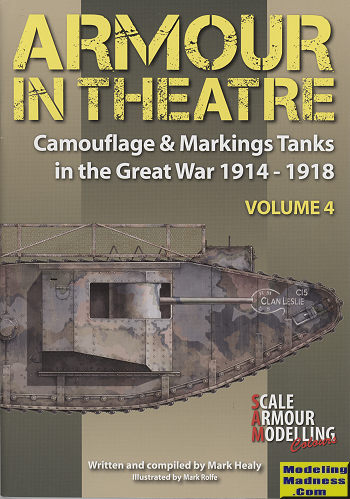 This is the
fourth volume of Guideline's 'Armour in Theater' series and concentrates
on tanks during WWI. It is much more than a simple camo and markings book, in
fact, that is only a rather small, but important part of the book.
This is the
fourth volume of Guideline's 'Armour in Theater' series and concentrates
on tanks during WWI. It is much more than a simple camo and markings book, in
fact, that is only a rather small, but important part of the book.Armour in Theater Volume 4: Tanks in the Great War 1914-1918
|
Author: |
Mark Healey |
|
Publisher |
Guideline Publications |
|
Price |
£16.00 |
|
Reviewer: |
|
| Notes: | ISBN 978-1-908565-19-1, 64 pages, softbound, A4 format. |
 This is the
fourth volume of Guideline's 'Armour in Theater' series and concentrates
on tanks during WWI. It is much more than a simple camo and markings book, in
fact, that is only a rather small, but important part of the book.
This is the
fourth volume of Guideline's 'Armour in Theater' series and concentrates
on tanks during WWI. It is much more than a simple camo and markings book, in
fact, that is only a rather small, but important part of the book.
This series has evolved to being more than the exterior look at the subjects. Instead, it provides a well done history of armor until the end of WWI. Each of the three major nations' efforts into developing what we now call tanks is provided. Understandably, most of the effort leans towards the British, and in particular the British Navy as they are the service that initially developed these vehicles. As many of you know, the word 'tank' was simply a cover for what was officially called a 'land ship'. The trapazoidal shape of these large, cumbersome, and relatively effective vehicles is immediately recognizable by most enthusiasts. What few realize is not only how hazardous it was to simply operate these vehicles, but also how prone to breakdown they were. It would not be too far out of line to say that they needed to be overhauled after each combat use.
The British also developed the light tank, which most of us know as the 'Whippet'. This is also a misnomer as their top speed was a breathtaking 8mph on a good day. However, like the larger heavy tanks, these turned out to be quite useful and played an important role, as well, especially late in the war.
The other nation to embrace the tank was France. It built several heavy tanks, each of which were almost totally useless and incapable of proper operation except on relatively flat ground with few obstacles. Where the French did their best was with the light tank. Their FT.17 was widely used post war and was still in some service 20 years later.
It was Germany who was late to the game. The German High Command saw the usefulness of these vehicles soon after their first use in 1916, but was unable to come up with anything that was their equal. Germany's lone tank was the ponderous A7V, manned by 18 men and a vehicle that made absolutely no impression on the war effort as much due to its low numbers as to its general ineffectiveness in combat.
The author also includes the operation of tanks in several battles including a rather detailed look at how it affected Germany's greatest defeat of the war at Amiens. There is a camo and markings section as well as some superb color profiles throughout the book. The photos that accompany this volume are very nicely chosen and give even more interest to the reader. The book reaches a rather interesting conclusion regarding the tank and it effect on the outcome of the war. In all, it is a very well done book and a real must have for enthusiasts.
May 2017.
My thanks to www.guidelinepublications.co.uk for providing the review copy. You can get this one direct using this link.
If you would like your product reviewed fairly and fairly quickly, please contact the editor or see other details in the Note to Contributors.